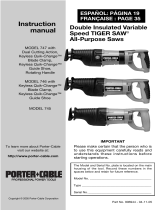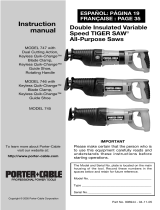
2
BATTERY TOOL USE AND CARE
PERSONAL SAFETY
GENERAL POWER TOOL SAFETY WARNINGS
WORK AREA SAFETY
ELECTRICAL SAFETY
POWER TOOL USE AND CARE
•Keepworkareacleanandwelllit. Cluttered or
dark areas invite accidents.
•Donotoperatepowertoolsinexplosiveatmos-
pheres,suchasinthepresenceofammable
liquids,gasesordust. Power tools create sparks
which may ignite the dust or fumes.
•Keep children andbystanders away while
operatingapowertool. Distractions can cause
you to lose control.
•Powertoolplugsmustmatchtheoutlet.Never
modifytheplug inanyway. Donotuse any
adapterplugswithearthed(grounded)power
tools.Unmodied plugs and matching outlets will
reduce risk of electric shock.
•Avoidbodycontactwithearthedorgrounded
surfacessuchaspipes,radiators,rangesand
refrigerators.There is an increased risk of electric
shock if your body is earthed or grounded.
•Donotexposepowertoolstorainorwetcondi-
tions.Water entering a power tool will increase
the risk of electric shock.
•Donotabusethecord.Neverusethecordfor
carrying,pullingorunpluggingthepowertool.
Keepcordawayfrom heat,oil,sharp edges
ormovingparts.Damaged or entangled cords
increase the risk of electric shock.
•Whenoperatingapowertooloutdoors,usean
extensioncordsuitableforoutdooruse.Use
of a cord suitable for outdoor use reduces the risk
of electric shock.
•Ifoperatingapowertoolinadamplocationis
unavoidable,useagroundfaultcircuitinter-
rupter(GFCI)protectedsupply.Use of an GFCI
reduces the risk of electric shock.
•Stayalert,watchwhatyouaredoinganduse
commonsensewhenoperatingapowertool.
Donotuseapowertoolwhileyouaretiredor
undertheinuenceofdrugs,alcoholormedi-
cation.A moment of inattention while operating
power tools may result in serious personal injury.
•Usepersonal protective equipment.Always
weareyeprotection. Protective equipment such
as dust mask, non-skid safety shoes, hard hat, or
hearing protection used for appropriate conditions
will reduce personal injuries.
•Prevent unintentional starting. Ensure the
switchisintheoff-positionbeforeconnecting
topowersourceand/orbatterypack,picking
uporcarryingthetool.Carrying power tools with
your nger on the switch or energising power tools
that have the switch on invites accidents.
•Removeanyadjustingkeyorwrenchbefore
turningthepowertoolon.A wrench or a key left
attached to a rotating part of the power tool may
result in personal injury.
•Donot overreach. Keep proper footing and
balanceatalltimes. This enables better control
of the power tool in unexpected situations.
•Dressproperly.Donotwearlooseclothingor
jewellery.Keepyourhair,clothingandgloves
awayfrommovingparts. Loose clothes, jewel-
lery or long hair can be caught in moving parts.
•Ifdevicesareprovidedfortheconnectionof
dustextractionandcollectionfacilities,ensure
theseareconnectedandproperlyused.Use of
dust collection can reduce dust-related hazards.
•Donotforcethepowertool.Usethecorrect
powertool for your application. The correct
power tool will do the job better and safer at the
rate for which it was designed.
•Donotusethepowertooliftheswitchdoesnot
turnitonandoff. Any power tool that cannot be
controlled with the switch is dangerous and must
be repaired.
•Disconnectthe plug from the power source
and/orthe battery packfrom the powertool
beforemaking any adjustments, changing
accessories,orstoringpowertools.Such pre-
ventive safety measures reduce the risk of starting
the power tool accidentally.
•Storeidlepowertoolsoutofthereachofchil-
drenanddonotallowpersonsunfamiliarwith
thepowertoolortheseinstructionstooperate
thepowertool.Power tools are dangerous in the
hands of untrained users.
•Maintainpowertools.Checkformisalignment
orbindingofmovingparts,breakageofparts
andany other condition that may affect the
powertool’soperation.Ifdamaged,havethe
powertoolrepairedbeforeuse.Many accidents
are caused by poorly maintained power tools.
•Keepcuttingtoolssharpandclean. Properly
maintained cutting tools with sharp cutting edges
are less likely to bind and are easier to control.
•Usethepowertool,accessoriesandtoolbits
etc.inaccordancewiththeseinstructions,tak-
ingintoaccounttheworkingconditionsand
theworktobeperformed.Use of the power tool
for operations different from those intended could
result in a hazardous situation.
•Rechargeonlywiththechargerspeciedby
themanufacturer.A charger that is suitable for
one type of battery pack may create a risk of re
when used with another battery pack.
WARNING READ ALL SAFETY WARNINGS AND ALL INSTRUCTIONS.Failureto
followthewarningsandinstructionsmayresultinelectricshock,reand/orseriousinjury.
Save
all warnings and instructions for future reference
. Theterm“powertool”inthewarn-
ingsreferstoyourmains-operated(corded)powertoolorbattery-operated(cordless)powertool.










